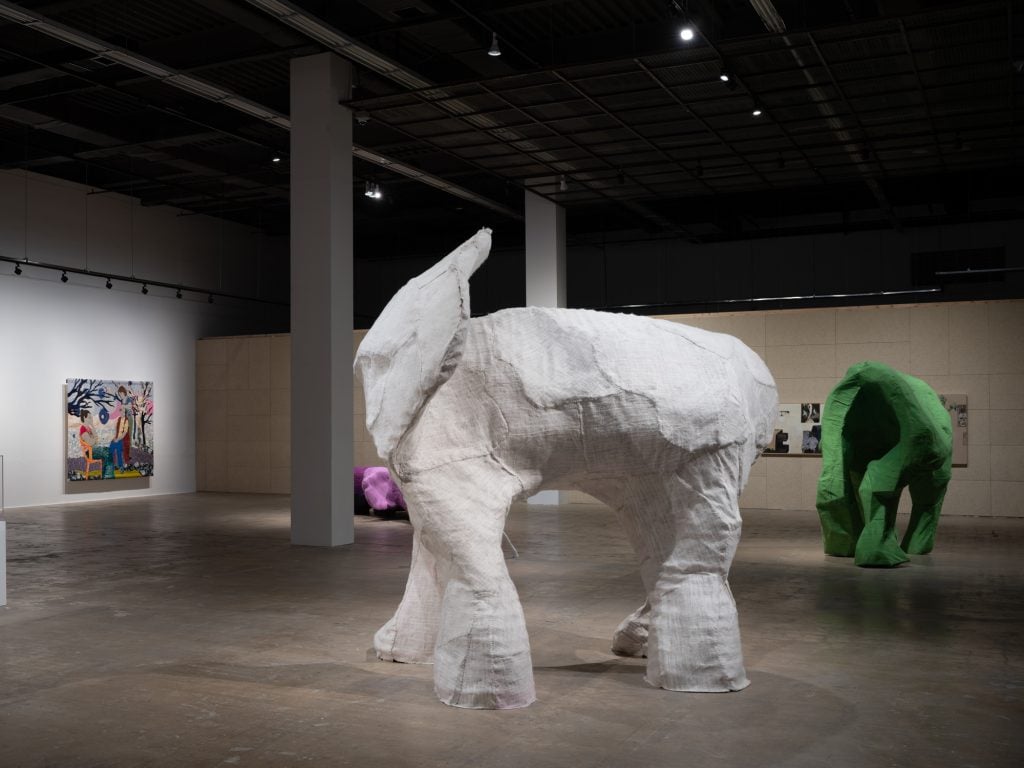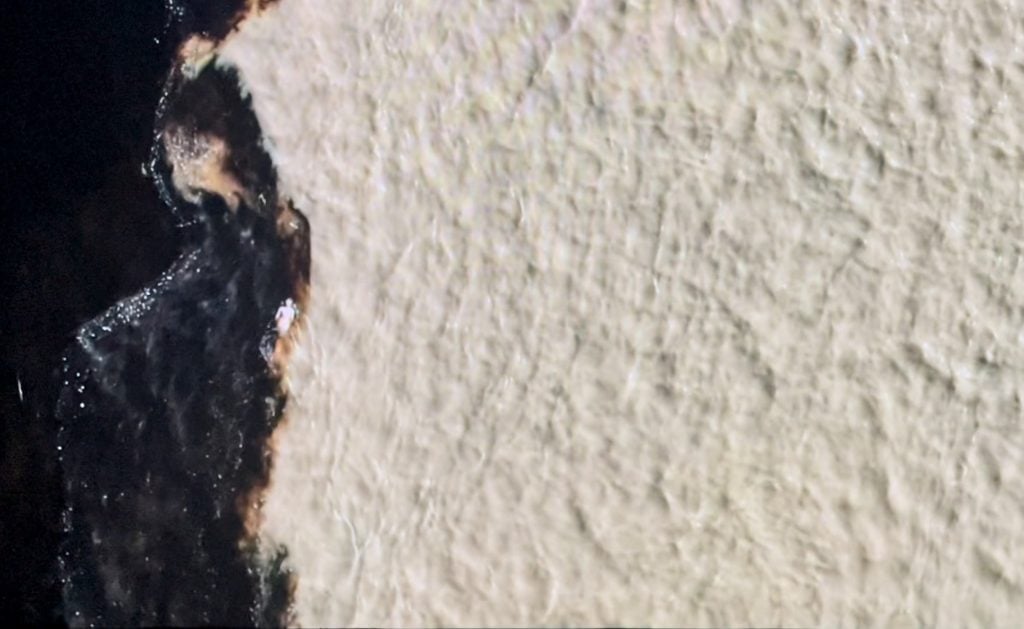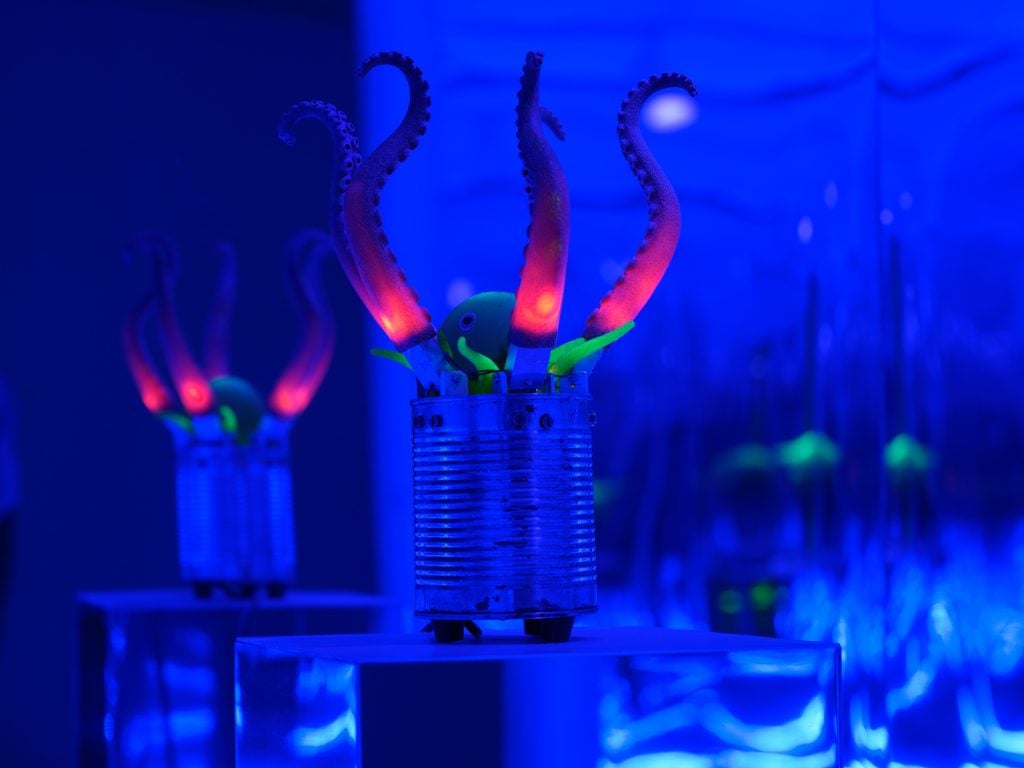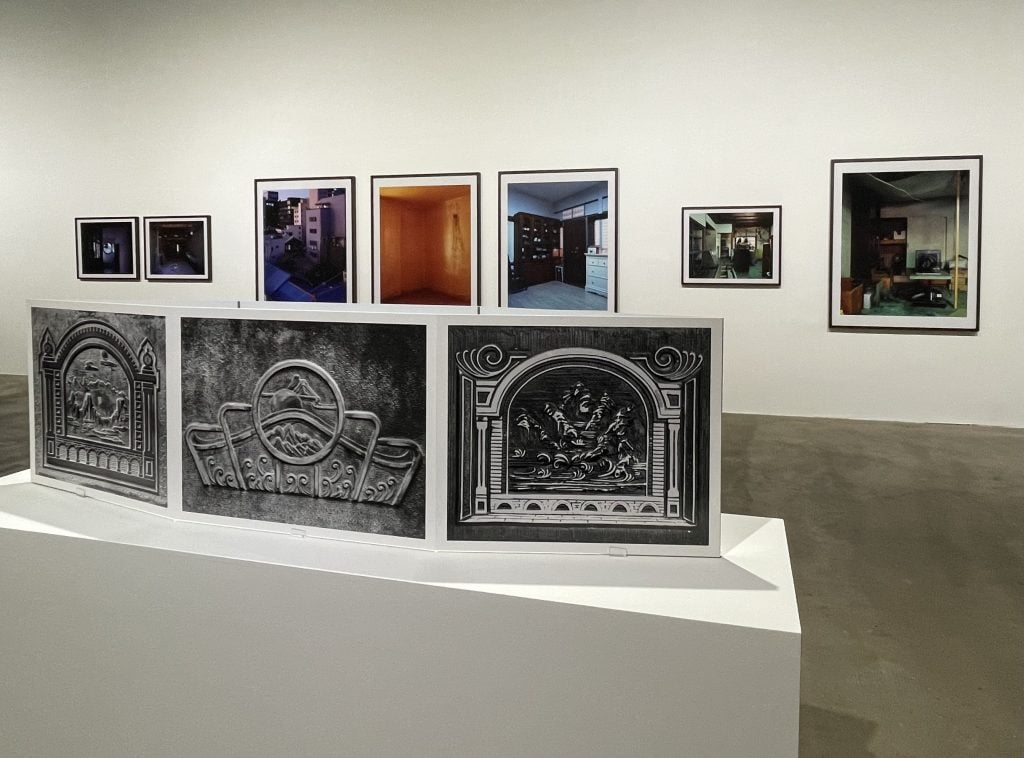The opening of the 14th Gwangju Biennial in South Korea on April 6 could have encountered a rainstorm and a communication breakdown that led to chaotic arrangements, but it was a success nonetheless.
It wasn’t because of the K-pop glamor brought to you by Super Junior’s Siwon Choi, who was named this edition’s biennial ambassador on stage; it also had little to do with the strong presence of the opposition Democratic Party, including Gwangju Mayor Kang Gi-jung. The real star was the magnificent main exhibition organized under the theme of “Soft and weak like waterby Tate Modern Senior Curator Sook-Kyung Lee, the first South Korean-born curator to lead the event since 2006.
Covering five galleries in the Gwangju Biennale exhibition hall as well as four other offsite venues, the beautifully set up exhibition proved to be more than just a show to impress, but a platform for important dialogues that aim to inspire.
Featuring 79 artists from around the world, the show is divided into four main sections: Luminous Halo, Ancestral Voices, Transient Sovereignty and Planetary Times. The biennale takes place in the South Korean city known for its fight for freedom and democracy may not be overtly political at first glance, but there is no shortage of politically charged yet poetic works that question and respond to pressing issues related to resistance, decolonization and the environment. Art here is like water – its softness and tenderness can be a powerful mediator that penetrates hard surfaces to bring about transformation.
Ahead of a full review of this expansive biennial event, we highlight five artists featured in the show who deserve global attention.
Oum Jeongsoon

Oum Jeongsoon, elephant without a trunk (2023). Courtesy of the artist and the Gwangju Biennale Foundation. Photo: Glimworkers.
WHO: Born in 1961 in Chung-ju, South Korea, Oum graduated from the College of Fine Arts at Ewha Woman’s University in Korea before continuing her studies at the Akademie der Bildenden Kunst in Munich, Germany, where she graduated in 1988. professor at KonKuk University in the 1990s and exhibited in Korea, Japan and Germany. She is the founder and director of the Our Eyes art exhibition and education center. She is based in Seoul.
Exhibited work: Installation work elephant without a trunk (2023), presented in the Luminous Halo section at Gwangju Biennale Exhibition Hall. The work won the artist the first Seo-Bo Park Art Prize at the Gwangju Biennale, with a cash prize of $100,000 sponsored by the famous 91-year-old Korean artist.
Why you should pay attention: In her ongoing project “Another Way of Seeing”, Oum traces the journey of the first elephant’s arrival in Korea from Indonesia 600 years ago. elephant without a trunk is an extension of this project, in which Oum reinterprets elephants through the experiences of visually impaired people and plays them in enlarged forms. These obscurely shaped “elephants” – some without trunks, others without their own bodies – are a reminder that “no one can see properly, no one can see the whole”. We can only see part of the world,” noted Frances Morris, director of Tate Modern and one of the five judges of the Park Seo-Bo Art Prize. Morris praised the artist for sending a strong message to the world in the post-pandemic era: “He defines life through strong bonds transcending genres and traditions that have been passed down to this day.”
Emilija Skarnulyte

Emilija Škarnulyte, Æqualia (2023), on view at the Gwangju Biennale. Photo: Vivienne Chow.
WHO: Born in 1987 in Vilnius, Lithuania, Škarnulytė is an artist and filmmaker working between documentary and imagination. The award-winning artist graduated from the Academy of Contemporary Art in Tromsø in Norway and her works have been collected by institutions from the Kadist Foundation and the Center Pompidou. She is the founder and co-director of Polar Film Lab and a member of the artist duo New Mineral Collective. It is based between Vilnius and Oslo.
Exhibited work: Æqualia (2023), an immersive video installation featured in Planetary Times at Gwangju Biennale Exhibition Hall.
Why you should pay attention: Škarnulytė does the news turning down the GASAG Art Prize last year in protest at Germany’s reliance on Russian energy amid its war with Ukraine. This year at the Gwangju Biennale, the artist may be back in the news for the art she has created. Æqualia is an enigmatic and fascinating work that features a mermaid-like creature navigating different bodies of water. The mythical creature swims through different rivers around the Amazon and at one point crosses the focal point between the black waters of the Rio Negro and the white waters of the Rio Negro. Sometimes the mermaid is seen playing with pink river dolphins, which are residents of the area. Echoing the theme of this subsection, the lyrical nine-minute film captures the beauty and mystery of nature. The mermaid’s navigation through different waters also inspires how we should act in the face of conflict and unpredictable circumstances.
Yuko Mohri

Yuko MohriI/O (2011-23), on view at the Gwangju Biennale. Photo: Vivienne Chow.
WHO: Born in Kanagawa in 1980, Mohri graduated from Tokyo University of the Arts and has held solo exhibitions around the world. His residencies with the Asian Cultural Council in New York, the Victoria & Albert Museum and the Camden Arts Center in London have expanded his global exposure. His works are part of the collections of the Center Pompidou in Paris, the M+ in Hong Kong and the Museum of Contemporary Art in Tokyo. She is based in Tokyo.
Exhibited work: Installation work I/O (2011-23), on view at the glass pavilion of the Horanggasy Artpolygon, one of the off-site venues.
Why you should pay attention: The installation artist has been a regular at biennials around the world since 2017, according to our survey last year, and it’s not hard to see why after seeing his work in Gwangju. I/O, which features a set of kinetic sculptures, is an ongoing series. But the artist gave it a new twist, adapting the work in situ to a local context. By collecting almost invisible dust and debris from the ground and sampling environmental elements such as airflow and humidity, Mohri’s work transforms these strange components into a “musical score” unique to Gwangju. The artist also links the work to Han Kang’s novel The white paper (2016) and the city’s multi-layered history, symbolizing the creation of a “tone of history that has never been written”. She expects to exhibit at the upcoming Art Basel in Switzerland with Mother’s Tankstation, with a solo exhibition in the gallery space in London due to open in September.
Anne Duk Hee Jordan

Anne Duk Hee Jordan, Goodbye, and thank you for all the fish (2023). Courtesy of the artist and Gwangju Biennale.
WHO: Jordan was born in Korea in 1978 and grew up in Germany. A free diver from an early age, Jordan’s installation work explores the intertwined relationships between humans and non-humans, as well as marine life, technology, food and sexuality. Humor also often has a part to play in the inspiring and delightful work of the artist. Jordan is based in Berlin.
Exhibited work: Goodbye, and thank you for all the fish (2023), on view in the basement of the Horanggasy Artpolygon, one of the offsite locations.
Why you should pay attention: Jordan has created a mysterious yet whimsical world with his elaborate installation spanning three rooms in the basement of this community art center on Yangmin Mountain. The mirrored halls, doused in black light and fluorescent colors, are filled with obscure objects and creatures that are inhabitants of a unique ecosystem that exists only in these halls. There are also non-human robotic inhabitants who can sense the presence of humans, as they begin to make cheerful gestures to greet visitors. It turns out that these robotic creatures are part of Jordan’s ongoing series “Artificial Stupidity” (2016–), and the title of the work is taken from Novacenea 2019 book by James Lovelock, the late scientist, environmentalist and futurist who has long inspired the artist’s contemplation of our future through an environmental lens.
Oh Suk Kuhn

Oh Suk Kuhn, “Enemy Property” series (behind, on the wall) and “Prosperity” series (in front). Photo: Vivienne Chow.
WHO: Born in 1979 in Incheon, South Korea, Oh studied photography at Nottingham Trent University in the UK before embarking on a career as an artist. He works with photography, a medium he chose to document and investigate the confluence between his personal and collective memories, and the ongoing trauma of the country’s war-torn and colonial history. Oh is based in Incheon.
Exhibited work: “Enemy Property” and “Prosperity” photographic series, exhibited at the Gwangju Exhibition Hall.
Why you should pay attention: At first glance, Oh’s series of subtle photographs might not be the most eye-catching compared to the elaborate installations surrounding his work. But these seemingly uneventful images tell important stories about Korea’s history that has long been forgotten or even unknown to outsiders. The “Enemy Property” series captures the “enemy houses” in Gwangju built by the Japanese during the colonial period that have been transformed over the years from their original state. His images depict enemy houses seen in Incheon and Busan (where the artist created a series and showed last year Busan Biennial). The “Prosperity” series captures symbols of longevity found in Korean culture that were actually created by appropriating designs and patterns from other cultures, such as Greek, Chinese, Japanese, and even Art Nouveau. . These very still images are like time capsules, created by Oh to process and question the history and narratives that still affect Korea today.
The Gwangju Biennale runs until July 9.
Follow Artnet News on Facebook:
Want to stay one step ahead of the art world? Subscribe to our newsletter to receive breaking news, revealing interviews and incisive reviews that move the conversation forward.
